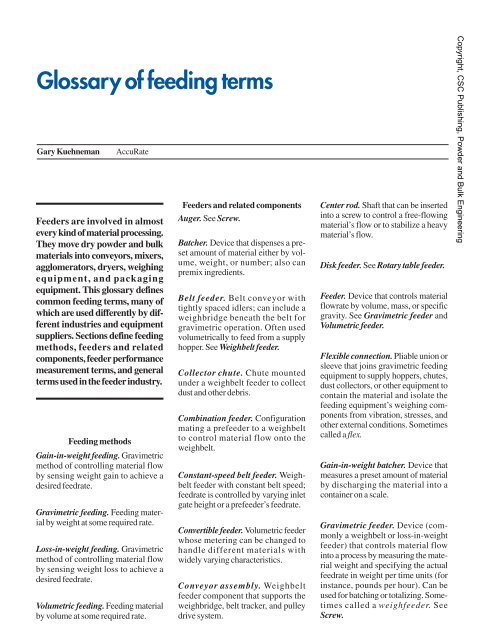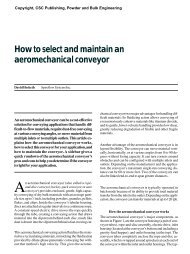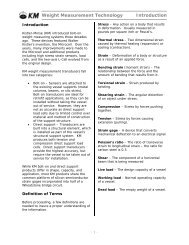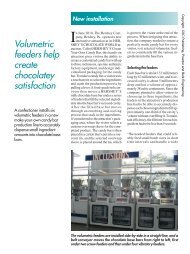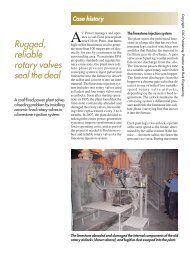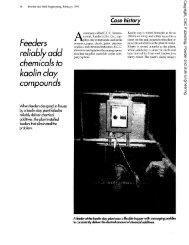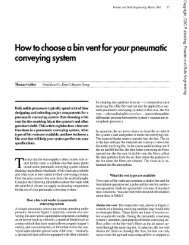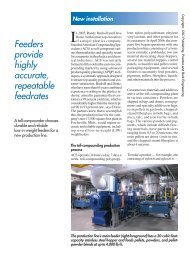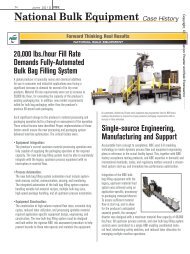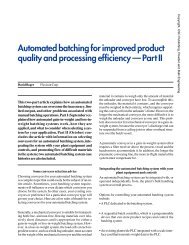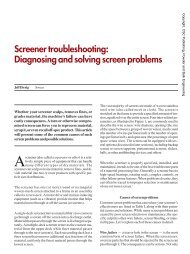Feeding Glossary - Powder and Bulk Engineering Magazine
Feeding Glossary - Powder and Bulk Engineering Magazine
Feeding Glossary - Powder and Bulk Engineering Magazine
Create successful ePaper yourself
Turn your PDF publications into a flip-book with our unique Google optimized e-Paper software.
<strong>Glossary</strong> of feeding terms<br />
Gary Kuehneman<br />
AccuRate<br />
Feeders are involved in almost<br />
everykindofmaterialprocessing.<br />
They move dry powder <strong>and</strong> bulk<br />
materials into conveyors, mixers,<br />
agglomerators, dryers, weighing<br />
equipment, <strong>and</strong> packaging<br />
equipment. This glossary defines<br />
common feeding terms, many of<br />
which are used differently by different<br />
industries <strong>and</strong> equipment<br />
suppliers. Sections define feeding<br />
methods, feeders <strong>and</strong> related<br />
components, feeder performance<br />
measurement terms, <strong>and</strong> general<br />
termsusedinthefeederindustry.<br />
<strong>Feeding</strong> methods<br />
Gain-in-weight feeding. Gravimetric<br />
method of controlling material flow<br />
by sensing weight gain to achieve a<br />
desired feedrate.<br />
Gravimetric feeding. <strong>Feeding</strong> material<br />
by weight at some required rate.<br />
Loss-in-weight feeding. Gravimetric<br />
method of controlling material flow<br />
by sensing weight loss to achieve a<br />
desired feedrate.<br />
Volumetric feeding. <strong>Feeding</strong> material<br />
by volume at some required rate.<br />
Feeders <strong>and</strong> related components<br />
Auger. See Screw.<br />
Batcher. Device that dispenses a preset<br />
amount of material either by volume,<br />
weight, or number; also can<br />
premix ingredients.<br />
Belt feeder. Belt conveyor with<br />
tightly spaced idlers; can include a<br />
weighbridge beneath the belt for<br />
gravimetric operation. Often used<br />
volumetrically to feed from a supply<br />
hopper. See Weighbelt feeder.<br />
Collector chute. Chute mounted<br />
under a weighbelt feeder to collect<br />
dust <strong>and</strong> other debris.<br />
Combination feeder. Configuration<br />
mating a prefeeder to a weighbelt<br />
to control material flow onto the<br />
weighbelt.<br />
Constant-speed belt feeder. Weighbelt<br />
feeder with constant belt speed;<br />
feedrate is controlled by varying inlet<br />
gate height or a prefeeder’s feedrate.<br />
Convertible feeder. Volumetric feeder<br />
whose metering can be changed to<br />
h<strong>and</strong>le different materials with<br />
widely varying characteristics.<br />
Conveyor assembly. Weighbelt<br />
feeder component that supports the<br />
weighbridge, belt tracker, <strong>and</strong> pulley<br />
drive system.<br />
Center rod. Shaft that can be inserted<br />
into a screw to control a free-flowing<br />
material’s flow or to stabilize a heavy<br />
material’s flow.<br />
Disk feeder. See Rotary table feeder.<br />
Feeder. Device that controls material<br />
flowrate by volume, mass, or specific<br />
gravity. See Gravimetric feeder <strong>and</strong><br />
Volumetric feeder.<br />
Flexible connection. Pliable union or<br />
sleeve that joins gravimetric feeding<br />
equipment to supply hoppers, chutes,<br />
dust collectors, or other equipment to<br />
contain the material <strong>and</strong> isolate the<br />
feeding equipment’s weighing components<br />
from vibration, stresses, <strong>and</strong><br />
other external conditions. Sometimes<br />
called a flex.<br />
Gain-in-weight batcher. Device that<br />
measures a preset amount of material<br />
by discharging the material into a<br />
container on a scale.<br />
Gravimetric feeder. Device (commonly<br />
a weighbelt or loss-in-weight<br />
feeder) that controls material flow<br />
into a process by measuring the material<br />
weight <strong>and</strong> specifying the actual<br />
feedrate in weight per time units (for<br />
instance, pounds per hour). Can be<br />
used for batching or totalizing. Sometimes<br />
called a weighfeeder. See<br />
Screw.<br />
Copyright, CSC Publishing, <strong>Powder</strong> <strong>and</strong> <strong>Bulk</strong> <strong>Engineering</strong>
Helix. See Screw.<br />
Inlet gate. Weighbelt feeder’s inlet<br />
opening (typically adjustable), which<br />
is positioned horizontally over the<br />
belt <strong>and</strong> shears the material bed to a<br />
roughly uniform level as material<br />
flows past the gate.<br />
Inlet slide gate. Horizontal sliding<br />
gate, located at a supply hopper’s bottom,<br />
that controls material flow to a<br />
weighbelt feeder’s inlet.<br />
Loss-in-weight batcher. Device used<br />
to measure a preset amount of material<br />
by discharging the material from a<br />
weighed container.<br />
Loss-in-weight feeder. Unit includes<br />
a hopper (called a weigh hopper)<br />
filled with material, mounted on a<br />
scale, <strong>and</strong> linked to a feeder; the<br />
feeder discharges material from the<br />
weigh hopper at a rate that achieves a<br />
specified weight loss per unit time on<br />
the scale.<br />
Master feeder. In ratio control, the<br />
feeder (or instrumentation) whose<br />
control value determines the setpoint<br />
of one or more other (slave) feeders.<br />
Master rate setter. Single-point flow<br />
controller <strong>and</strong> throughput totalizer<br />
that controls the setpoints of slave<br />
feeders to allow variation in the total<br />
production rate while keeping the correct<br />
proportion of ingredients.<br />
Oscillating feeder. See Vibrating<br />
feeder.<br />
Plow feeder. Either a rotary or fixed<br />
device: Rotary device has a rotary arm<br />
in a square or circular hopper that<br />
sweeps material to the central discharge;fixeddevicehasaconelocated<br />
above the central discharge that guides<br />
material down the cone’s sides <strong>and</strong> beneaththeconethroughthedischarge.<br />
Prefeeder. Variable-speed, volumetric<br />
metering device such as a screw<br />
feeder, rotary valve, or vibrating tray;<br />
typically used on a weighbelt feeder<br />
to aid the flow of a floodable or hardto-flow<br />
material from the feeder’s<br />
inlet section onto the belt. Prefeeder’s<br />
volumetric capacity is slaved to that<br />
of the weighbelt feeder.<br />
Quick-clean feeder. Feeder used in<br />
applications requiring frequent <strong>and</strong><br />
thorough cleaning (for instance, for<br />
product changeovers).<br />
Ratio control. Feeder control configuration<br />
with the setpoint of one or<br />
more feeders (called slave feeders) directly<br />
proportional to the master<br />
feeder’s setpoint.<br />
Rotary valve. Fixed- or variablespeed<br />
metering device that prevents a<br />
fine powder from flooding or transfers<br />
material between areas of differing<br />
pressure by isolating one part of<br />
the process from other parts. Sometimes<br />
called a rotary feeder, rotary<br />
feed valve, or rotary airlock.<br />
Sampling valve. Valve located at a<br />
weighbelt feeder’s discharge to divert<br />
material flow for sampling <strong>and</strong> calibration.<br />
Screw. Helical or closed-flight augerlike<br />
component used in a screw feeder<br />
to move material or control its flow.<br />
See Screw feeder.<br />
Screw feeder. Screw in a trough or<br />
cylindrical tube or sleeve used to feed<br />
material from a supply hopper to<br />
processequipment;sometimesusedto<br />
partiallymixmaterialsasthey’retransported.<br />
Twin-screw type uses two<br />
screws that may or may not be intermeshed.<br />
Screw design variations include<br />
constant, stepped, <strong>and</strong> variable<br />
pitch; variable diameter; variable shaft<br />
diameter; <strong>and</strong> variable pitch <strong>and</strong> shaft<br />
diameter.<br />
Slave feeder. Feeder whose control<br />
value is received from a master feeder<br />
<strong>and</strong> is proportional to the master<br />
feeder’s control value or a measured<br />
or set process variable. See Master<br />
feeder <strong>and</strong> Ratio control.<br />
Copyright, CSC Publishing, <strong>Powder</strong> <strong>and</strong> <strong>Bulk</strong> <strong>Engineering</strong><br />
Loss-in-weight feeder.<br />
Reciprocating feeder. Unit consisting<br />
of one or more flat steel plates that<br />
shake back <strong>and</strong> forth to propel material<br />
into a process; also called a reciprocating-plate<br />
feeder.<br />
Rotary tables. Device with a powerdriven<br />
circular plate (called a table)<br />
that rotates directly beneath a supply<br />
hopper’s discharge; an adjustable feed<br />
collar controls material flow. Table’s<br />
rotation evenly distributes material<br />
across the table (or into a groove in the<br />
table) so a hinged plow or other shear<br />
device can divert the material into the<br />
process. Also called a disk feeder.<br />
Strain gauge. Weight transducer<br />
(load cell) used in a gravimetric feeder<br />
for measuring deformations in the<br />
feeder’s load-bearing element; device<br />
works by converting applied load or<br />
pressure to a voltage-based output by<br />
sensing a change in the electrical resistance<br />
of a fine wire network when the<br />
network isapplied to the feeder’sloadbearing<br />
element.<br />
Surge hopper. Large-capacity carbon<br />
steel or stainless steel storage container,<br />
either located on top of a feeder<br />
or freest<strong>and</strong>ing, that ensures an adequate<br />
supply of material to the feeder.
Vibrating feeder. Shallow flat-bottomed<br />
pan or trough vibrated in a sinusoidal<br />
fashion by an external drive<br />
to propel material forward, often onto<br />
a belt conveyor; also called a vibrating<br />
tray feeder or oscillating feeder.<br />
Vibrating tray prefeeder. Shallow,<br />
flat-bottomed, vibrating tray or trough<br />
installed directly upstream from a<br />
weighbelt feeder that h<strong>and</strong>les a fibrous<br />
or other difficult-to-h<strong>and</strong>le material;<br />
the tray’s sinusoidal vibration propels<br />
the material across <strong>and</strong> off the tray,<br />
controllingmaterialflowtothefeeder.<br />
Volumetric feeder. Device that controls<br />
material flow into the process by<br />
setting the metering device’s displacementorrotationalspeed;feedrateisexpressed<br />
as volume per unit time rather<br />
thanweightornumberperunittime.<br />
Weighbelt feeder. Short belt conveyor<br />
that controls belt speed <strong>and</strong> material<br />
flowrate either by weighing the entire<br />
weighbelt assembly or, with a larger<br />
feeder, by weighing a cross-section of<br />
material passing over the belt’s weighbridge;<br />
the feeder’s mass flow is determined<br />
by multiplying belt loading<br />
(pounds per foot) by belt speed (feet<br />
per minute). See Weighbridge.<br />
Weighbelt meter. Weighbelt feeder<br />
that runs at a fixed speed or volumetric<br />
capacity <strong>and</strong> totalizes material<br />
throughput in a process; can also provide<br />
a mass-flow signal to another instrument<br />
in the process for ratioing<br />
additional ingredients with the major<br />
ingredient’s uncontrollable flow.<br />
Weighbridge. In a larger weighbelt<br />
feeder, the structure that supports the<br />
load-sensing device <strong>and</strong> provides the<br />
platform on which the weighbelt rests.<br />
Weighfeeder.SeeGravimetricfeeder.<br />
Feeder performance<br />
measurement terms<br />
Accuracy. Feeder’s degree of conformity<br />
to a process st<strong>and</strong>ard, usually expressed<br />
as a percentage of error at a<br />
specific statistical confidence level.<br />
See Repeatability, Sigma, <strong>and</strong> St<strong>and</strong>ard<br />
deviation.<br />
Calibration. To st<strong>and</strong>ardize flow or<br />
batch measurement by correcting for<br />
deviation from a st<strong>and</strong>ard. Also to determine,<br />
by measuring or comparing<br />
with a st<strong>and</strong>ard, the correct value of<br />
each scale reading on a meter or other<br />
device, or the correct value for each<br />
setting of a control knob.<br />
Catch sampling. At specific intervals<br />
over a certain time period, collecting<br />
<strong>and</strong>weighingmaterialdischargedfrom<br />
afeedertodeterminefeederaccuracy.<br />
Linearity. Measurement of how well<br />
or how poorly a gravimetric feeder<br />
delivers the desired feedrate over the<br />
feeder’s full operating range.<br />
Repeatability. Degree to which repeated<br />
measurements of a feeder’s feedrate<br />
over short time periods at a given<br />
setpoint coincide, usually expressed in<br />
units of variation or, more precisely, as<br />
a percentage error at a specific statisticalconfidencelevel.Graphicallyrepre-<br />
sented as a distribution curve; a normal<br />
(Gaussian)distributionat2sigmaisthe<br />
industry st<strong>and</strong>ard defining feeder performancequality.SeeSigma<strong>and</strong>St<strong>and</strong>arddeviation.<br />
Sigma. The true variation of a feeder’s<br />
feedrate around its mean; a sigma’s<br />
value closely approximates a st<strong>and</strong>ard<br />
deviation’s value, but the term sigma<br />
isn’t interchangeable with the term<br />
st<strong>and</strong>ard deviation. For a given feedrate,<br />
1 sigma is the expressed percentage<br />
specifying the range in which 65<br />
percent of all sample values will fall; 2<br />
sigma (the industryst<strong>and</strong>ard) is theexpressed<br />
percentage specifying the<br />
range in which 95 percent of all sample<br />
values will fall; <strong>and</strong> 3 sigma is the<br />
expressed percentage specifying the<br />
range in which 99 percent of all sample<br />
values will fall. See Repeatability<br />
<strong>and</strong> St<strong>and</strong>ard deviation.<br />
Stability. Measurement of a gravimetric<br />
feeder’s ability to operate within<br />
tolerance over time.<br />
St<strong>and</strong>ard deviation. Measurement of<br />
the dispersion of sample weights<br />
about their mean; when the st<strong>and</strong>ard<br />
deviation is small, most of the sample<br />
values are near the mean. See Repeatability<br />
<strong>and</strong> Sigma.<br />
General terms<br />
Belt loading. Measurement of material<br />
weight per conveyor belt unit<br />
length; used to determine a weighbelt<br />
feeder’s actual feedrate or material<br />
throughput.<br />
Cascading.Whenaslavefeeder’sfeedrate<br />
changes in direct proportion to a<br />
changeinthemasterfeeder’sfeedrate.<br />
Copyright, CSC Publishing, <strong>Powder</strong> <strong>and</strong> <strong>Bulk</strong> <strong>Engineering</strong><br />
Cycle time. (1) Total elapsed time between<br />
identical points in two successive<br />
<strong>and</strong> identical batching operations.<br />
(2) In continuous loss-in-weight feeding,<br />
the sum of the times required to<br />
empty <strong>and</strong> refill the weigh hopper.<br />
Quick-disconnect volumetric<br />
feeder (disassembled).<br />
Weighbelt feeder.<br />
Deflection. In gravimetric feeding,<br />
the total measured displacement from<br />
a zero condition to full scale at the<br />
load-sensing point.
Dribble feeding. In batching <strong>and</strong><br />
packaging, reducing the feedrate or<br />
material flowrate near batch completion<br />
or when the package is nearly<br />
filled to avoid overshooting the desired<br />
batch or weight or volume.<br />
Feedrate. Actual amount of material<br />
(expressed in appropriate weight or<br />
volume units) discharged per unit of<br />
time; for instance, pounds per hour or<br />
cubic feet per hour.<br />
Flooding. Extreme, liquid-like, rapid<br />
material flow usually caused by aeration.<br />
See Wild flow.<br />
Formula control. See Recipe control.<br />
Headload. Force or pressure exerted<br />
on a feeder or process equipment by<br />
material weight in a supply hopper.<br />
Heel. Portion of material occupying<br />
the inlet area in a feeder or process<br />
equipment.<br />
Local control. Directly registering<br />
the desired feedrate setpoint on the<br />
feeder controller. See Ratio control.<br />
Metering. Typically with a weighbelt<br />
feeder,measuring(ratherthancontrolling)<br />
an intermittent or uncontrollable<br />
material flow’s total weight; used for<br />
monitoring material inventory or slaving<br />
other process equipment.<br />
Minor ingredient. Material forming a<br />
small part of the total formula, often<br />
requiring a highly accurate feedrate or<br />
portion control due to the material’s<br />
expense or effect.<br />
Overload. In loss-in-weight feeding, a<br />
condition where too much material in<br />
the weigh hopper causes the weight to<br />
exceed the feeder’s weigh scale range.<br />
cent flight, measured parallel to the<br />
screw axis.<br />
Proportioning. In continuous feeding,<br />
controlling an ingredient’s flowrate<br />
in proportion to the flowrate of<br />
one or more other ingredient; one ingredient’s<br />
flowrate is described as a<br />
percent of another’s flowrate. Sometimes<br />
called ratioing.<br />
Ratioing. See Proportioning.<br />
Recipe control. Controlling the formula<br />
of all ingredients in a particular<br />
mixture by specifying the total flowrate<br />
<strong>and</strong> the percentages (for a total<br />
100 percent) for each ingredient.<br />
Sometimes called formula control.<br />
Refill. Period during a loss-in-weight<br />
feeding cycle when the weigh hopper<br />
is refilled with material.<br />
Response time. Time a feeder requires<br />
to readjust from one set of defined<br />
conditions to another set.<br />
Sequencing. Incorporating time delays<br />
in feeder starting <strong>and</strong> stopping to<br />
coordinate processing operations so<br />
they’ll meet material transport or residence<br />
time requirements.<br />
Setpoint. Feedrate the feeder is trying<br />
to achieve or the actual feedrate; a<br />
perfectly tuned feeder’s actual feedrate<br />
is equal to the feeder’s setpoint.<br />
Tare. In gravimetric feeding, an<br />
empty container’s weight; deducted<br />
from the gross weight of a material<br />
<strong>and</strong> its container to determine net<br />
weight.<br />
Tolerance. Feeder’s specified performance<br />
limits.<br />
weight <strong>and</strong> metering speed measurements<br />
to determine actual mass flow<br />
<strong>and</strong> varies the metering device’s<br />
speed to control flowrate.<br />
Turndown. Measurement of the<br />
range over which a feeder can operate<br />
within specified performance limits<br />
(tolerance); expressed in relation to<br />
either full-scale or setpoint values.<br />
Underrange. In gravimetric feeding,<br />
a condition where the desired feedrate<br />
falls below the feeding equipment’s<br />
operating range.<br />
Wild flow. Uncontrollable flow of<br />
material. See Flooding.<br />
Zero condition. When a weight-sensing<br />
device indicates zero when no<br />
load is applied. Sometimes called<br />
zero-load balance or empty balance.<br />
Zeroing. In gravimetric feeding, a<br />
method of adjusting the weight- or<br />
mass-sensing device to indicate zero<br />
when no load is applied. Sometimes<br />
called zero adjustment.. PBE<br />
For further reading<br />
Find more information on feeders <strong>and</strong><br />
feeding in articles listed under “Feeders”<br />
in <strong>Powder</strong> <strong>and</strong> <strong>Bulk</strong> <strong>Engineering</strong>’s<br />
comprehensive “Index to<br />
articles” (later in this issue <strong>and</strong> at<br />
www.powderbulk,com).<br />
Copyright, CSC Publishing, <strong>Powder</strong> <strong>and</strong> <strong>Bulk</strong> <strong>Engineering</strong><br />
Overrange. In gravimetric feeding, a<br />
condition where the desired feedrate<br />
exceeds the feeder’s capacity.<br />
Pitch. Distance from any screw flight<br />
to the corresponding point on an adja-<br />
Totalizing. In gravimetric feeding,<br />
counting <strong>and</strong> indicating (or printing)<br />
the sum of material throughput<br />
weights.<br />
True rate. In gravimetric feeding, a<br />
flow-control method that multiplies<br />
Gary Kuehneman is vice president of<br />
sales <strong>and</strong> marketing at AccuRate, PO<br />
Box 208, Whitewater, WI 53190; 262-<br />
473-2441, fax 262-473-4384<br />
(grk@sarinc.com). This article is<br />
reprinted from <strong>Powder</strong> <strong>and</strong> <strong>Bulk</strong> <strong>Engineering</strong>’s<br />
December 1991 issue.


